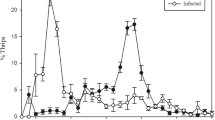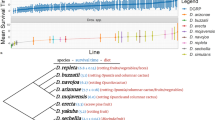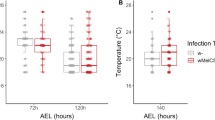Abstract
The sandfly Phlebotomus papatasi transmits Leishmania major, the agent of cutaneous leishmaniasis, in desert and savannah regions of the Old World1, where seasonal stress of dehydration and heat reduces the quantity of sugar in plant leaves2. Without essential sugar, only a few flies that feed on leaves can survive for long enough to deposit eggs and transmit Leishmania3,4. Accordingly, selection for hunger tolerance may also select for pathogen susceptibility in flies. Here we provide evidence of a link between these advantageous and costly5,6 properties by testing the susceptibility of flies selected by sugar deprivation and of flies from irrigated and arid habitats.
Similar content being viewed by others
Main
The experimental flies were obtained from a colony maintained on sucrose solution that was established in 1983 using flies from a desert habitat in the Jordan Valley. Susceptibility to infection with L. major promastigotes, the flagellated, parasitic form that inhabits sandflies, was evaluated sporadically using a standard procedure (Table 1)7. The previously high infection rate (338 of 394 flies, 85.7%) has declined in recent years to only 27.0% (48 of 178).
Experimental native plants Atriplex halimus (Chenopodiaceae) and Malva nicaeensis (Malvaceae), and the domestic Bougainvillea glabra (Nyctaginaceae), were chosen in a dry area. Sugar levels4,8 in the leaves of these plants were 3.6–13.8 times lower than in those of irrigated conspecifics. Groups of female P. papatasi were each fed exclusively on branches of one of the plants4 and other groups were starved until about half of the flies died (4–6 days). The survivors and control groups, one previously maintained for 6 days on 30% sucrose solution and another of day-old flies, were then infected7. Significantly more infections, including greater numbers of parasites, were found in flies selected for hunger tolerance compared with control flies (Table 1).
As the increased susceptibility to parasitic infection could have resulted from pre-infection hunger rather than from being selected, we tested day-old progeny of hunger-selected females. The frequency of infection in the progeny series was 64.3% (9 of 14), 79.7% (59 of 74) and 65.6% (21 of 32) (parents fed on B. glabra or M. nicaeensis or starved, respectively), whereas only 25.4% (45 of 177) of control flies were infected. This difference is statistically as significant as that of the parent generation (Table 1). Similar differences in susceptibility were also seen after progeny of hunger-selected and unselected flies were infected with amastigotes, the mammalian parasite form of L. major (results not shown). Assuming that hunger resistance and host competence for L. major improve with size, we measured and found no difference between the experimental and control fly groups (results not shown).
We also tested the correlation between the abundance of plant sugar in an oasis (Neot-Hakikar, Israel) and its scarcity at an arid site (in the Jordan Valley), and the susceptibility of the local P. papatasi populations to L. major. We first tested trapped flies for the presence of sugar in the gut3,8 — most of the oasis flies (69 of 72, 95.8%), but only one-third of the arid-site flies (60 of 186, 32.3%), were positive. We then infected first-generation progeny of these populations with L. major promastigotes7. Only 24.8% (25 of 101) of the oasis progeny retained parasites (mean ± s.e. per fly, 243 ± 71 promastigotes) compared with 82.5% (156 of 189) of the progeny of arid-site flies (mean ± s.e. per fly, 3,412 ± 686 promastigotes). We conclude that the oasis-adapted population is less susceptible to L. major than are similar flies from an arid area.
The cost of parasitic infection seems to be sufficient to elicit natural selection against competent hosts9. As far as we know, our findings represent the first evidence that this may be compensated for by linkage to endurance against environmental stress. Seasonal and incidental stress are prevalent in the life of insects10, including those that are vectors of disease, and selection may often favour lines of parasites that are adapted to stress-resistant vectors.
References
Ashford, R. W. & Bettini, S. in The Leishmaniases in Biology and Medicine Vol. 1 (eds Peters, W. & Killick-Kendrick, R.) 365–424 (Academic, London, 1987).
Hopkins, W. G. Introduction to Plant Physiology (Wiley, New York, 1995).
Schlein, Y. & Jacobson, R. L. Med. Vet. Entomol. 13, 65–71 (1999).
Schlein, Y. & Jacobson, R. L. J. Med. Entomol. 37, 319–324 (2000).
Schlein, Y., Jacobson, R. L. & Messer, G. Proc. Natl Acad. Sci. USA 89, 9944–9948 (1992).
Schaub, G. A. Parasitol. Today 10, 463–468 (1994).
Schlein, Y., Warburg, A., Schnur, L. F. & Shlomai, J. Acta Tropica 40, 65–70 (1983).
Van Handel, E. Anal. Biochem. 19, 193–194 (1967).
Yan, G., Severson, D. W. & Christensen, B. M. Evolution 51, 441–450 (1997).
Harshman, L. G., Hoffmann, A. A. & Clark, A. G. J. Evol. Biol. 12, 370–379 (1999).
Zar, J. H. Biostatistical Analysis 4th edn (Prentice-Hall, New Jersey, 1999).
Author information
Authors and Affiliations
Corresponding author
Additional information
brief communications is intended to provide a forum for both brief, topical reports of general scientific interest and technical discussion of recently published material of particular interest to non-specialist readers. Priority will be given to contributions that have fewer than 500 words, 10 references and only one figure. Detailed guidelines are available on Nature's website (http://www.nature.com) or on request from nature@nature.com
Rights and permissions
About this article
Cite this article
Schlein, Y., Jacobson, R. Hunger tolerance and Leishmania in sandflies. Nature 414, 168 (2001). https://doi.org/10.1038/35102679
Issue Date:
DOI: https://doi.org/10.1038/35102679
This article is cited by
Comments
By submitting a comment you agree to abide by our Terms and Community Guidelines. If you find something abusive or that does not comply with our terms or guidelines please flag it as inappropriate.



